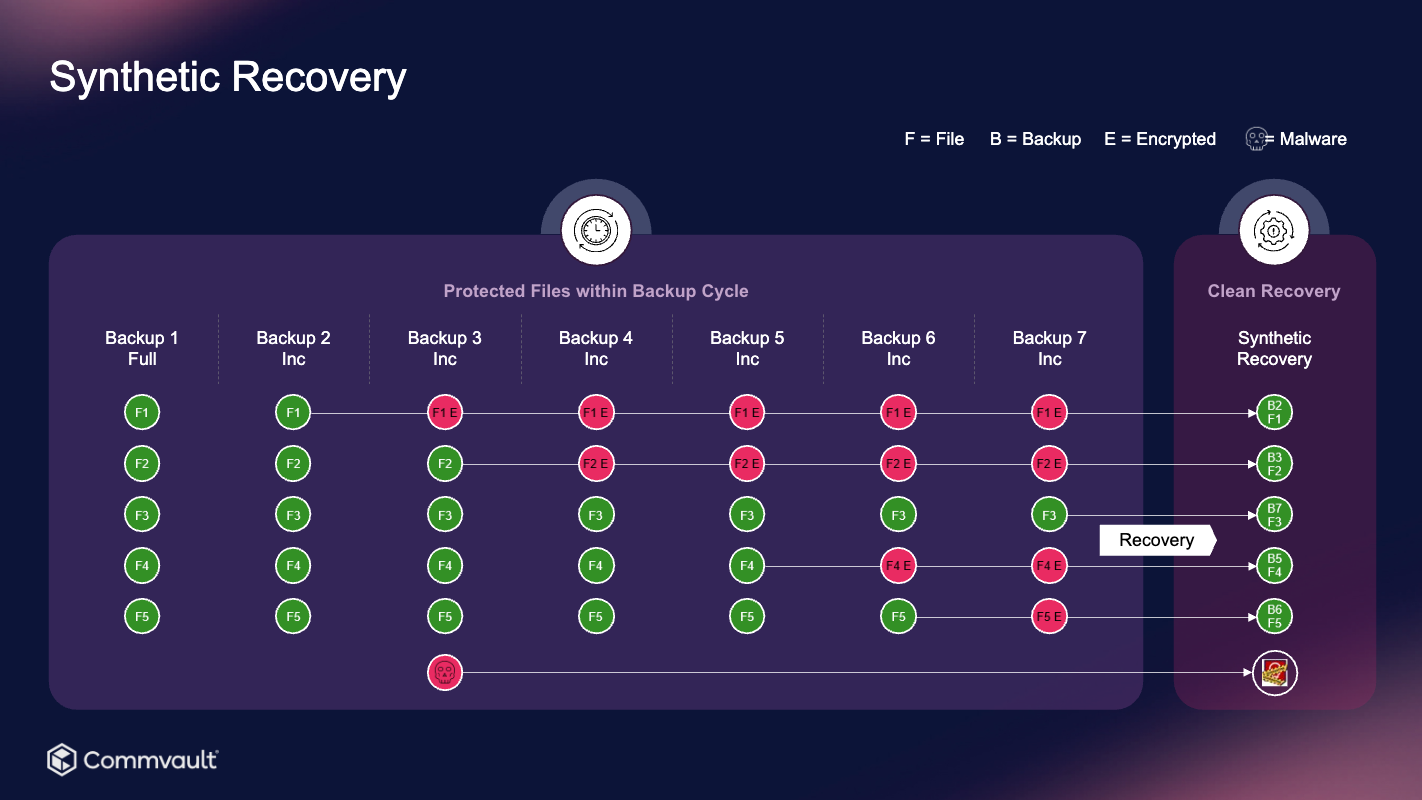Key Takeaways
- Synthetic Recovery™ automates finding a clean recovery point and assembling only the most recent uncorrupted versions, enabling clean, fast restores across your backup estate.
- By excluding encrypted or malicious files before recovery begins, it helps prevent reinfection and minimizes unnecessary rollback.
- AI-enabled, multi-engine threat detection (behavioral analytics, signatures, machine learning, heuristics, YARA/Hash, and partner signals) powers precise identification of good data.
- The approach transforms recovery from reactive triage to a strategic, automated resilience capability within the Commvault Cloud Unity platform.
When cyberattacks strike, recovery confidence is everything. The ability to restore operations quickly – and know that the data you’re bringing back is clean – separates the resilient from the vulnerable.
With exclusive Synthetic Recovery™, Commvault announced a breakthrough innovation as part of the Commvault Cloud Unity platform release. Enabled by AI and Commvault’s industry-leading multi-engine threat detection capability, Threat Scan, Synthetic Recovery helps organizations achieve one of the most elusive goals in cyber resilience: clean, fast, and complete recovery.
The Confidence Gap in Cyber Recovery
Even the best-protected environments can harbor hidden threats. Ransomware and other malware can remain dormant for days or weeks before activating, compromising systems and even backups.
When that happens, traditional recovery approaches – manual scans, isolated recovery environments, and trial-and-error restore – can waste valuable time, drive unnecessary data rollback, and risk reintroducing malware into production systems.
Enter Synthetic Recovery, designed to close this confidence gap in cyber recovery.
Clean Data, Fast: The Power of Synthetic Recovery
Synthetic Recovery automates the process of Cleanpoint™ identification, assembly, and restore of only the most recent uncorrupted file versions across entire backup data estates.
By drawing on AI-enabled insights across multiple backups, Commvault can assemble a curated recovery point that can help:
- Speed up restoration by automating clean data assembly, reducing downtime from hours to minutes.
- Prevent reinfection by excluding encrypted or malicious files before recovery begins.
- Minimize rollback by keeping the most current, validated file versions of good data.
- Simplify recovery across workloads, clouds, and storage environments.
The result? Faster recoveries, cleaner outcomes, and unified operations that strengthen enterprise resilience from the inside out.

AI Precision at Work
Synthetic Recovery is powered by Commvault’s AI-enabled multi-engine threat detection and response – a system that combines behavioral analytics, static signatures, machine learning, heuristic detection, YARA-rule and Hash scanning, and security partner signals to spot both known and zero-day threats with exceptional accuracy.
This intelligent automation helps Commvault customers build assurance that every recovery is validated, clean, and secure – not only restoring your data, but also your confidence in it.
Unified Resilience for Modern Operations
For today’s IT and security teams, Synthetic Recovery represents more than a feature – it’s a mindset shift. It transforms recovery from a reactive process into a strategic, automated resilience capability.
By bringing together cloud-native protection, advanced detection, and identity resilience in one platform, Commvault empowers enterprises to move faster, recover smarter, and operate with certainty – even in the face of the unexpected.
FAQs
Q: What is Synthetic Recovery?
A: Synthetic Recovery™ is a new Commvault capability within the Threat Scan offering that automates clean and verifiable data recovery after a cyberattack. It identifies and assembles the most recent uncorrupted file versions from entire backup estates across multiple virtual machines and files, creating a single, curated recovery point. This helps organizations restore operations faster, cleaner, and with confidence, while minimizing rollback and reinfection risk.
Q: Why is Synthetic Recovery important now?
A: Modern ransomware and malware threats are increasingly stealthy, often lying dormant for days or weeks before activation. During that time, malicious data can silently enter backup sets. When that happens, traditional recovery methods risk restoring infected data. Synthetic Recovery helps solve this by combining AI-enabled threat detection, Cleanpoint™ identification, and automated clean data assembly to enable that only verified, healthy data is brought back online.
Q: How does Synthetic Recovery differ from traditional recovery methods?
A: Traditional clean recovery workflows rely on manual steps such as creating isolated recovery environments, manually restoring data for external scanning, and guessing at the “last known good” recovery point.
Synthetic Recovery removes that guesswork. Using Commvault’s indexed backup data and AI-enabled threat detection, it automatically identifies and replaces compromised files, generating a dataset ready for immediate recovery – no manual validation required.
Q: What role does AI play in Synthetic Recovery?
A: Synthetic Recovery leverages Commvault’s AI-enabled multi-engine threat detection and response framework. This includes:
- Behavioral analysis to detect unusual file activity.
- Machine-learning models that recognize encryption and ransomware patterns.
- Static and signature-based scanning for known threats.
For a complete list of Commvault Threat Scan detection techniques, request a demo.
Q: How does Synthetic Recovery help reduce reinfection risk?
A: Because Synthetic Recovery excludes files identified as malicious or encrypted, it helps validate that compromised data never re-enters production environments. This can break the reinfection cycle, giving teams confidence that every restored file has been validated as safe – based on AI analysis and Commvault’s multi-engine threat intelligence.
Pauline List is a Product Marketing Specialist at Commvault.



